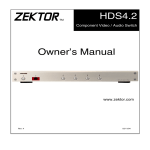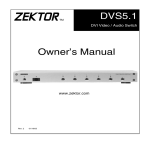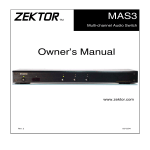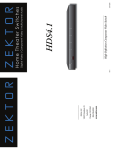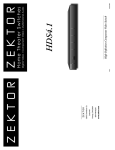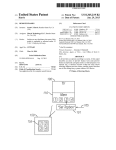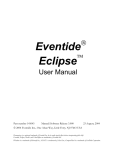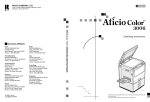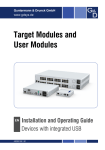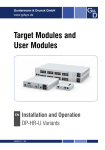Download Zektor HDS4.2 Owner`s manual
Transcript
ZEKTOR TM HDS4 Component Video / Audio Switch Owner’s Manual www.zektor.com Rev: 9 03/11/2004 Important Safety Instructions! Read all instructions for prior to installation of your product. Retain this User's Manual for future reference. Adhere to all safety and operation instructions. Before cleaning this product, unplug from the wall outlet. Do not use liquid cleaning products. Use a damp cloth for cleaning. Do not use this product on an unstable cart, stand, or table. The product may fall, causing serious injury to a child, and serious damage to the product. Ensure that any attached cables cannot be tripped over. This product is supplied with a UL Class 2 power supply as indicated on the product packaging. Use this product only with the supplied power supply. If you are unsure about the type of AC power in your home, consult your product dealer or a local power company. Power cords should be routed so they will not be stepped on or rolled over. If your product is not operating properly, do not attempt to service this product yourself. Refer to a qualified service personnel. 2 An HDS4 Overview A Description of the HDS4 The HDS4 is a 4 input, Audio / HDTV Video switch. It supplies a single HDTV Component Video output. The HDS4 is a passive switch, using high quality gold plated relays to switch signals. Digital audio is switched using highspeed digital electronics. The HDS4 accepts either a Coax SPDIF input, or a Toslink optical input. Both Coax and Toslink signals are made available on the output of the HDS4. Channel selection is accomplished using any user supplied, standard IR remote control. Your HDS4 Purchase Includes: • The HDS4. • A 9v, 500ma A.C. Adapter. • The HDS4 Owners Manual. 3 Using the HDS4 with a Remote Control Operation of the HDS4 is done fully through the use of a universal remote control. A remote control is not supplied with the HDS4, yet the versatile programming modes of the HDS4 allows the HDS4 to work with virtually any remote control. The next section "Programming your Remote Control" on page 5, describes how to setup your remote controller. After your remote control is programmed the following describes the pre-programmed functions of the HDS4. There are 10 separate remote controlled commands understood by the HDS4. They are: POWER TV VCR CBL / SAT DVD RCVR 1 2 3 4 5 6 7 8 9 0 ENT PIP VOL +_ CH + _ • POWERTOGGLE.The HDS4 can be toggled from standby to power on, and back to standby using a single button of the remote. • SELECTIN1. Select input 1. If the HDS4 is in standby mode, it will power on and then select input 1. • SELECTIN2. Select input 2. If the HDS4 is in standby mode, it will power on and then select input 2. • SELECTIN3. Select input 3. If the HDS4 is in standby mode, it will power on and then select input 3. • SELECTIN4. Select input 4. If the HDS4 is in standby mode, it will power on and then select input 4. • POWEROFF. The HDS4 can be set to standby mode by pressing a single button of the remote. Once the HDS4 is in standby mode, further presses of the POWEROFF button will be ignored. This command is useful when using the “macro” feature of some programmable remote controls, and is used when it is unknown whether the HDS4 is already in standby mode or not. • POWERON. The HDS4 can be powered on from standby by pressing a single button of the remote. Once the HDS4 is power on, further presses of the POWERON button will be ignored. This command is useful when using remote controls that allow “macro” programming, where it is unknown whether the HDS4 is already power on or not. • SETDIMMODE. Toggles through three different bright/dim display modes. They are: Bright all the time. Dim all the time. Bright for 4 seconds after any keypress, and then automatically dim. • SELECT+. Select the next higher input. If input 4 is currently selected, then this command will cause input 1 to be selected. • SELECT-. Select the next lower input. If input 1 is currently selected, then this command will cause input 4 to be selected. 4 Programming your Remote Control Setting up your Universal Remote Control Before use, the HDS4 requires a Universal Remote control to be programmed to control the HDS4. Or alternatively, the HDS4 can learn to use most existing remote controls. The simplest way begin using the HDS4, is to program your remote control to act like a Jerrold Cable Box. Once this is done you will be able to immediately start using your HDS4. Check your remote’s user manual for instructions on programming your remote control. The following table shows the Jerrold Cable codes for a few different brands of Universal Remote Controllers: Make Device Code Sony CBL 001 One For All CBL 0476 Sanyo CBL 303 GE / RCA CBL 046 X10 CBL 062 Zenith / Phillips / Magnavox CBL 552 5 Using Different Remote Codes Using Alternate Component Keys on your Remote The HDS4 will also respond to alternate component key codes. Allowing you to use an unused TV, VCR, RCVR or one of the added AUX positions many remotes include. Setting up the HDS4 to respond to alternate component codes is a two step process. You must first program your universal remote control to behave as one of the alternate components. You must then teach the HDS4 to respond to the alternate component codes. Programming your remote to different components The HDS4 will respond to five different pre-programmed component codes, they are: Jerrold Cable Box, Symphonic TV, Yamaha VCR, Awia DVD and a Nakamichi Receiver. The following table shows the different component buttons and codes used to program a few different universal remotes. One For Sanyo RCA All Make Device Sony Zenith X10 Jerrold CBL 001 0476 303 046 552 062 Symphonic TV 023 0171 104 189 520 202 Yamaha VCR 040 0038 238 009 025 022 Awia DVD 015 0641 N/A 350 N/A N/A Nakamichi RCVR 086 N/A N/A N/A N/A N/A If your remote control’s model matches one of the above, read your remote’s user manual for instructions on programming your remote control, then use the above device and manufacturer codes to setup your remote. If your remote is not included above list, or the manufacturer code given does not work, then you will have to follow your remote controls instructions for programming one of the above components and search for a proper match. See the next section. Or teach the HDS4 a new set of codes, See: "Learning New Remote Codes" on page 8. Teaching the HDS4 a new component code After your remote control has been programmed to act like one of the 5 built in code-sets, teaching the HDS4 to use the new code set is simple. 6 STEP 1 1 2 3 4 STEP 2 1 2 3 4 1 Place the HDS4 in standby mode. This is the factory default mode on power up, and if it has not been changed, you can unplug the HDS4 and plug it back in and it will power up in standby mode (at this point only the power indicator light is lit and glowing RED). If the HDS4 does not power up in standby mode, follow the steps given in "Restoring the HDS4 to Factory Defaults" on page 13. 2 On your remote control press the buttons in the following sequence, after each button press verify that the remote IR indicator flashes. (If you make a mistake, you can start over by pressing POWER twice.): • POWER • CHANNEL + • POWER • CHANNEL 3 The HDS4 will power up indicating the new component codes have been accepted. STEP 3 1 2 3 4 Searching for a component code in your remote Assuming you do not have a remote listed in this user manual you will have to follow your remote controls programming sequences to find a compatible component that the HDS4 understands, or you can go to the section "Learning New Remote Codes" on page 8, to teach the HDS4 new keys for individual commands. To search for compatible component codes you must place the HDS4 in standby mode and try manufacturer codes in your remote control until one of them causes the HDS4’s IR indicator LED to flash. STEP 1 1 2 3 4 STEP 2 1 2 3 4 1 Place the HDS4 in standby mode. This is the factory default mode on power up, and if it has not been changed, you can unplug the HDS4 and plug it back in and it will power up in standby mode (at this point only the power indicator light is lit and glowing RED). If the HDS4 does not power up in standby mode, follow the steps given in "Restoring the HDS4 to Factory Defaults" on page 13. 2 Try different manufacturer codes until one of them causes the IR indicator light on the HDS4 to blink when pressing the POWERTOGGLE key. When found, go to back to "Teaching the HDS4 a new component code" on page 6, to teach the HDS4 to use the new component code. 7 Learning New Remote Codes Teaching the HDS4 to use new remote control keys If your remote does not have one of the pre-programmed component codes, or you simply want to re-map the HDS4 functions to other keys on your remote, the HDS4 can be taught to use new keys. To teach the HDS4 to respond to new keys, you need to have the remote control(s) you want to use ready, and setup in the manner you want it to be used. STEP 1 1 2 3 4 STEP 2 1 2 3 4 1 Place the HDS4 in standby mode. This is the factory default mode on power up, and if it has not been changed, you can unplug the HDS4 and plug it back in and it will power up in standby mode (at this point only the power indicator light is lit and glowing RED). If the HDS4 does not power up in standby mode, follow the steps given in "Restoring the HDS4 to Factory Defaults" on page 13. 2 Using a pen or pencil, press and HOLD the SETUP button on the back panel of the HDS4 (located near the power jack) for around 4 seconds, until the HDS4 powers up, and the Power indicator on the front panel of the HDS4 begins to blink GREEN. The HDS4 is now ready to accept new remote control key codes. For each of the following steps: 1 2 3 4 • You may press a key on your Remote Control, if accepted, the IR indicator light will blink, and the key will be learned as the new key for the given function. The HDS4 will advance to the next step. • Or you may press and release the SETUP key on the back panel of the HDS4, this indicates to the HDS4 to skip this key, and the whatever key was previously programmed for that function will be retained. The HDS4 will advance to the next key. • Or you may press and hold the SETUP key on the back panel until the HDS4 returns to standby mode. This will end learn mode, all keys already programmed will be remembered, and all the keys skipped will retain their previously programmed values. The HDS4 will advance to Step 13. 3 The Power indicator blinks slowly, and input 1 is selected. STEP 3 1 2 3 4 Press the key on your remote that you want to use as the new key for SELECTIN1. 1 BLINK 8 4 The Power indicator blinks slowly, and input 2 is selected. STEP 4 1 2 3 4 Press the key on your remote that you want to use as the new key for SELECTIN2. 1 BLINK 5 The Power indicator blinks slowly, and input 3 is selected. STEP 5 1 2 3 4 Press the key on your remote that you want to use as the new key for SELECTIN3. 1 BLINK 6 The Power indicator blinks slowly, and input 4 is selected. STEP 6 1 2 3 4 Press the key on your remote that you want to use as the new key for SELECTIN4. 1 BLINK 7 After a pause, the Power indicator blinks 2 times, and repeats. STEP 7 1 2 3 4 Press the key on your remote that you want to use as the new key for POWERTOGGLE. 2 BLINKS 8 After a pause, the Power indicator blinks 3 times, and repeats. STEP 8 1 2 3 4 Press the key on your remote that you want to use as the new key for SELECTIN-. 3 BLINKS 9 After a pause, the Power indicator blinks 4 times, and repeats. STEP 9 1 2 3 4 Press the key on your remote that you want to use as the new key for SELECTIN+. 4 BLINKS 10 After a pause, the Power indicator blinks 5 times, and repeats. STEP 10 1 2 3 4 Press the key on your remote that you want to use as the new key for SETDIMMODE. 5 BLINKS 9 11 After a pause, the Power indicator blinks 6 times, and repeats. STEP 11 1 2 3 4 Press the key on your remote that you want to use as the new key for POWERON. 6 BLINKS 12 After a pause, the Power indicator blinks 7 times, and repeats. STEP 12 1 2 3 4 Press the key on your remote that you want to use as the new key for POWEROFF. 7 BLINKS STEP 13 1 2 3 4 13 The HDS4 will return to the standby mode indicating a return to normal operations. The newly programmed codes will now operate your HDS4. Remote Control Learning Caveats Some remote control codes will work better than others. We’ve designed the HDS4 to work with a great majority of remote control codes, however a few brands use non-standard ways of transmitting their remote control codes that may not be compatible with the HDS4. In these somewhat rare circumstances you will have to program your remote control to a different manufacturer code, and/ or use different buttons on your remote. When programming the HDS4, if the IR indicator light blinks, and the HDS4 moves on to the next step, then the remote controller’s key code has been accepted. If the IR indicator does not blink, it indicates the HDS4 does not understand that particular manufactures code and you will have to choose another. In some cases the remote key code will be accepted, however the range will be limited. If the range of a programmed key is unacceptable, you will have to choose a different manufacturer and try again. 10 Setting the Bright / Dim / Auto-dimming Modes Setting the Display intensity modes of the HDS4 The front panel display of the HDS4 can be set to Bright, Dim or an Auto-dimming mode where the display brightens for 4 seconds after any function is selected and then autodims. Setting the mode is simply a matter of toggling through the three modes: • Bright Mode. When pressing the SETDIMMODE key to toggle to this state, the display will turn bright and remain that way. • Dim Mode. When pressing the SETDIMMODE key to toggle to the Dim mode, the display will go dim and remain that way. • Auto-dimming Mode. When pressing the SETDIMMODE key to toggle to the Auto-dimming mode, the display will turn bright, then flash to dim, then flash back to bright, indicating the Auto-dimming mode has been selected. After 4 seconds of no activity, the display will smoothly dim to the dim setting. 11 Setting Power On Defaults The HDS4 power on default mode When toggling between Standby mode and PowerOn the HDS4 will remember all it’s current settings. After completely powering down the HDS4 (by unplugging the AC wall adapter), upon restoring power (by plugging the AC wall adapter back in), it will power up in a user settable default mode. This is useful in situations where the HDS4 is externally switched by a power strip. The factory default settings for initial power on are: • Initial power up in Standby mode. • Input 1 selected when powered on. • Auto-dimming mode selected. Changing the HDS4 power on defaults Teaching the HDS4 new power on default settings consists of placing the HDS4 in the preferred initial power on mode, and pressing and releasing the SETUP button on the back panel of the HDS4. 1 Select an initial power on input. STEP 1 1 2 3 4 Using the SELECTIN1 - SELECTIN4 keys, or the SELECT+ or SELECTkeys, choose the desired power on default input. 2 Select the initial Bright / Dim / Auto-dimming mode. STEP 2 1 2 3 4 Using the SETDIMMODE key, choose the desired power on default Bright / Dim / Auto-dimming mode. 3 Select the initial power mode, Standby or Powered on. STEP 3 1 2 3 4 STEP 4 1 2 3 4 or 1 2 3 4 Using the POWERTOGGLE, POWERON or POWEROFF keys, choose the initial power on mode. 4 Press and release the SETUP button located on the back panel of the HDS4. The power Indicator light on the HDS4 will blink once to indicate the new power on setting have been saved. The previous picture shows the default power up mode, as being set to the standby mode. It may also be set to the power on mode, by pressing and releasing the setup key while power is on, as shown here. 12 Restoring the HDS4 to Factory Defaults Restoring the HDS4 to the factory defaults There are many ways to program the HDS4’s remote capabilities. Most learning modes require the HDS4 to be in standby mode before learning can begin. If the remote used to control the HDS4 were to be lost, and the HDS4 were programmed to power on during initial power up (as described in "Setting Power On Defaults" on page 12), there would be no way to reprogram the HDS4 to accept new remote control codes. Therefore a means of resetting the HDS4 to its factory on defaults has been included. Resetting the HDS4 to factory on default is done by removing power to the HDS4. The AC wall adapter must be unplugged, so that the HDS4 is completely without power. The SETUP key is then pressed and held while power is restored to the HDS4, after about three seconds the power indicator will flash three times indicating the HDS4 has been reset to power on defaults. STEP 1 1 2 3 4 STEP 2 1 2 3 4 STEP 3 1 2 3 4 1 Remove all power from the HDS4, this can be done by unplugging the AC wall adapter from the back of the HDS4, or unplugging the AC adapter from the wall, or by using a switched power strip. Nothing should be lit on the HDS4. 2 Using a pen or pencil, press AND HOLD the SETUP button on the back panel of the HDS4. While continuing to HOLD the SETUP key, reapply power to the HDS4. When power is applied, the power indicator light and the IR indicator light will both light up. 3 Continue to HOLD the SETUP key and after about three seconds the power indicator will blink RED three times indicating the HDS4 has been reset to its factory defaults. The HDS4 factory defaults, are: • Control codes used are the Jerrold Cable Box codes. • Default power up mode is standby. • Default selected input when powered on is input 1. • Default brightness mode is Auto-dimming. 13 14 Connecting Components to your HDS4 Video switching The HDS4 has 5 general purpose, high bandwidth connections that may be used for several different formats of video. In the typical application, you would use the three connectors labeled Y/G, Pr/ R, and Pb/B for component video, and the two labeled L/H and R/V for analog stereo audio. The switching circuitry for all five signals have the same bandwidth, so in cases where routing analog signals are not needed, the L/H and R/V connectors can be used to switch horizontal and vertical sync as required for VGA signals from a computer (aka RGBHV). Another application is switching one source to multiple display devices. This is not to be confused with a distribution amplifier that can drive multiple displays simultaneously. The HDS4 will allow switching one device to one display device at a time. Audio switching The HDS4 allows for the input of SPDIF digital audio as well as Toslink optical digital audio. Both signals are mixed internally, and switched as a single signal. You can mix and match digital audio signals freely, however when connecting each input device, choose either SPDIF or Toslink on any given channel, but not both. Connecting both to the same input channel will interrupt the audio data. When the signal reaches the output, it is converted back into both SPDIF and Toslink, so either connection may be used to feed the signal to the AV receiver. Since the digital audio data is switched differently than the video signals, it is not bidirectional. Typical applications The following are some ideas on typical HDS4 usage. 15 Example 1 Progressive Scan DVD Player Game Console with component video output and optical digital audio output with component video output and optical digital audio output HDTV Cable with component video ouput, coaxial digital audio output and analog audio output Pr/R Pb/B L/H 1 Pr/R Pb/B L/H Toslink Y/G SPDIF R/V 2 Pr/R Pb/B L/H Y/G SPDIF R/V Toslink Y/G SPDIF R/V 3 Pr/R Pb/B L/H Y/G SPDIF R/V 4 Pr/R Pb/B L/H Y/G SPDIF R/V Toslink Toslink OUT Toslink DC input To AV Receiver/Amp with digital audio input RPTV with Component Video Inputs In this component video application, the DVD player and the game console have Toslink audio outputs, however the HD cable box has only SPDIF and L/R analog audio outputs, both of which must be used. The HDS4 will internally convert the SPDIF to Toslink for the output, but the L/R analog audio is not converted, and must also be connected to the AV receiver. Set your AV receiver to auto mode so that it will pick the best source of audio. 16 Example 2 Progressive Scan DVD Player Game Console with component video output and optical digital audio output with component video output and optical digital audio output Home Theater PC with RGBHV (VGA) output and coaxial digital audio HDTV Cable with component video ouput, coaxial digital audio output Pr/R Pb/B L/H 1 Pr/R Pb/B L/H Toslink Y/G SPDIF R/V 2 Pr/R Pb/B L/H Y/G SPDIF R/V Toslink Y/G SPDIF R/V 3 Pr/R Pb/B L/H Y/G SPDIF R/V 4 Pr/R Pb/B L/H Y/G SPDIF R/V Toslink Toslink OUT Toslink DC input To AV Receiver/Amp with digital audio input FPTV with component video and RGBHV (VGA) inputs In this component video/VGA mixed application, some input devices are component video, and some are VGA (RGBHV). When selecting the PC on input 4, the projector must also be switched to RGBHV mode, and back to HDTV mode for the other 3 component video signals on inputs 1 to 3. Note: that this can be automated with macro programming on higher end remotes and control systems. 17 Example 3 Progressive Scan DVD Player with component video output and optical digital audio output To AV Receiver/Amp FPTV with digital audio input with component video and RGBHV (VGA) inputs Pr/R Pb/B L/H 1 Pr/R Pb/B L/H Toslink Y/G SPDIF R/V 2 Pr/R Pb/B L/H Y/G SPDIF R/V Toslink Y/G SPDIF R/V 3 Pr/R Pb/B L/H Y/G SPDIF R/V 4 Pr/R Pb/B L/H Y/G SPDIF R/V Toslink Toslink PLASMA TV OUT Toslink DC input RPTV with Component Video Inputs with Component Video Inputs In this output switching application, one DVD player can feed 1 of 4 displays (3 shown here). Since there is only one source of audio, the audio does not need to be switched, and can be routed directly to the AV receiver. 18 Warranty Information Warranty Policy ZEKTOR, LLC warrants this product against defects in material and workmanship under normal use and service for one year from the original date of purchase. ZEKTOR, at its option, shall repair or replace the defective unit covered by this warranty. In order to keep this warranty in effect, the product must have been handled and used as prescribed in the instructions accompanying this warranty. This warranty does not cover any damage due to accident, misuse, abuse, or negligence. This warranty is valid only if the product is used as specified in the product documentation. Repair or replacement, as provided under this warranty, is your exclusive remedy. ZEKTOR shall not be liable for any incidental or consequential damages. Implied warranties of merchantability and fitness for a particular purpose on this product are limited in duration to the duration of this warranty. Some states/countries do not allow the exclusion or limitation of incidental or consequential damages, so the above limitation or exclusion may not apply to you. Some states/countries do not allow limitations on how long an implied warranty lasts, so the above limitation may not apply to you. This warranty gives you specific legal rights, and you may also have other rights that vary from state to state and country to country. Return & Exchange Shipment of product is as advertised by product. Upon receipt of merchandise inspect product carefully, should you find that the product does not meet your expectations, or satisfaction, contact us at once and tell us your concerns, so we may make every effort to satisfy your purchase. Instructions for returning items Please retain the dated sales receipt as evidence of the date of purchase. You will need it for any warranty service. If you bought the product through a dealer, installer, or reseller, you will need to return the product to the point of sale. E-Mail us, or call us, using the information listed under “Customer Service Contact Information” on the following page, for a Return to Manufacturer Authorization (RMA) number. Describe briefly the reasons for your requested return. You must receive an RMA # before you return any goods to us, the RMA # must appear on your return packing label or on the outside of the box, Merchandise without a RMA # will be refused, and no credit will be issued. RMA's are valid for ten (10) days from date of issuance. All returned merchandise must be shipped in the original packaging. If it is not in the original packaging, ZEKTOR will not be held liable for damage during shipment. Shipments of returns must be prepaid, and we will not accept COD returns. 19 Customer Service Contact Information: ZEKTOR, LLC 12675 Danielson Court Suite 401 Poway, CA 92064 Phone: (858) 748-8250 Email: [email protected] 20




















